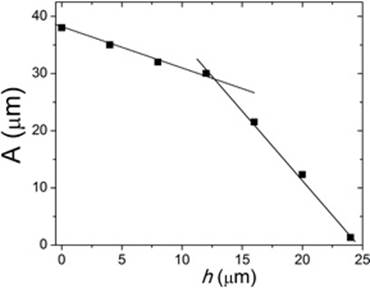Reports: DNI954168-DNI9: Using Confocal Rheometry to Study Single Particle Dynamics in Shear Thickening Suspensions
Xiang Cheng, PhD, University of Minnesota
Our research goal of the proposed project is to design novel colloidal suspensions with desired non-Newtonian flow behaviors. We achieve such a control by tuning inter-particle attractions, particle shapes and confinement of system. With the support of ACS Petroleum Research Fund over the last year (08/31/2014-09/01/2015), we have investigated two of these control parameters (confinement and inter-particle interactions) and have made significant progress in our study. Below, I shall briefly describe our results and our research plan for the next support period of the PRF grant.
(1) Using fast confocal microscopy, we have investigated the rheology of colloidal suspensions and imaged the dynamics of single particles under strong spherical confinement.
In our experiments, we use fluorescent polymethylmethacrylate (PMMA) spheres of two different sizes ds = 1.29 um and dl = 1.64 um as our colloidal particles (Fig. 1a). PMMA particles are suspended in a mixture of decalin and cyclohexyl bromide that matches both the density and refractive index of the particles. To confine particles in a confined geometry with well-defined length scales, we first disperse the colloidal suspension into an aqueous solution of gelatin agent at 70 C to create an oil-in-water emulsion. When temperature is lowered to the room temperature, the aqueous phase solidifies through gelation. The gelation traps particles of different sizes at the oil-water interface and confines colloidal suspensions inside spherical cavities of various sizes (Fig. 1a, b). To measure the influence of confinement on the rheological properties of colloidal suspensions, we measure the mean-squared displacements of confined particles, which can be converted into the rheology of the suspensions inside confined cavities through microrheology. Fig. 1c shows the relaxation time of particles inside cavities of different sizes. Suspensions confined inside small cavities show much slower relaxations than those confined in large cavities with similar volume fractions. Since the relaxation time is proportional to the suspension viscosity, the results indicate that confinement dramatically increases the viscosity of suspensions. More interestingly, we found that the apparent viscosity of suspensions diverges at a fixed volume fraction φ = 0.59, independent of the degree confinement. Thus, our results demonstrate the effect of confinement on the linear viscosity of colloidal suspensions and also shed light on the dynamics of colloidal glass transition under strong confinement. The work is under revision for the publication in Physical Review Letters.
In the research next year, we will study the nonlinear rheology of confined colloidal suspensions by shearing the confined colloidal suspensions in our specially-designed fast confocal rheoscope.
(2) We have also investigated the rheology and the dynamics of active suspensions using confocal rheoscope. Active suspension is a new class of non-equilibrium colloidal suspensions with examples including suspensions of self-driven synthetic colloidal particles, swarming bacteria, and self-propelled cytoskeletons. Different from conventional colloidal suspensions, an active fluid is a dispersion of a large number of self-propelled units, which possesses unique inter-particle hydrodynamic interactions. Due to this distinct inter-particle interactions, active fluids show unusual rheological properties, which hold the promise for the control of suspension rheology.
Recent theoretical works have predicted that at certain shear rates, active suspensions can enter a regime where its apparent viscosity vanishes. In such a “superfluid” state, the suspensions exhibit a shear-banding behavior. Macroscopic rheology measurements using E. coli suspensions as a model of active suspensions have indeed confirmed the existence of zero-viscosity state. However, detailed microscopic particle dynamics including the predicted shear banding have not been experimentally studied. Using confocal rheometry, we have investigated the rheology and the shear profile of active suspensions. Our preliminary results indeed show the existence of shear banding in sheared active fluids (Fig. 2). Such a shear banding behavior profoundly modifies the rheological behaviors of active suspensions. In the next year, we will further investigate the variation of shear banding under different shear conditions.
In addition to shear banding in active suspensions, PRF also supported us to investigate the flow behaviors of active suspensions through microrheology. We have studied the diffusion of passive ellipsoids in a quasi-two-dimensional active fluids. Our study reveals a nonlinear enhancement of both translational and rotational diffusions of ellipsoids. More importantly, we uncover an anomalous coupling between translation and rotation that is strictly prohibited in the classic Brownian diffusion. Combining experiments with theoretical modeling, we show that such an anomaly arises from generic stretching flows induced by swimming bacteria. Our work illustrates a universal organizing principle of active suspensions and sheds new light on fundamental transport processes in microbiological systems. The results from this work is under review for publication.
PRF grant has fully supported one of my postdocs on the study of active suspensions. Moreover, it also partially supported materials and lab supplies used in the confined colloidal project. PRF is my first external grant. It strongly supported the startup of my research. The projects supported by the PRF grant have already resulted in two submitted papers over the last year. More importantly, using the preliminary results obtained from the PRF-supported projects, my proposal has won the NSF Career Award last year.
Figure captions:
Figure 1: Confined colloidal liquids in spherical cavities. (a) A confocal image showing a cross-section of a suspension along the equator of a spherical cavity with radius R = 7 um. (b) A 3D reconstruction of the same suspension from a stack of confocal images. (c) Particle relaxation time as a function of volume fractions inside cavities of different sizes, with (from top to bottom) R = 11 um, 21 um, 83 um and bulk. The normalization factor \tau_0 = 2.87 s is the Brownian relaxation time of small particles in the dilute limit.
Figure 2: Shear profile of sheared active suspensions. The amplitude of oscillatory shears, A, as a function of the height, h, above the shear plate. A shear banding behavior can be identified.













